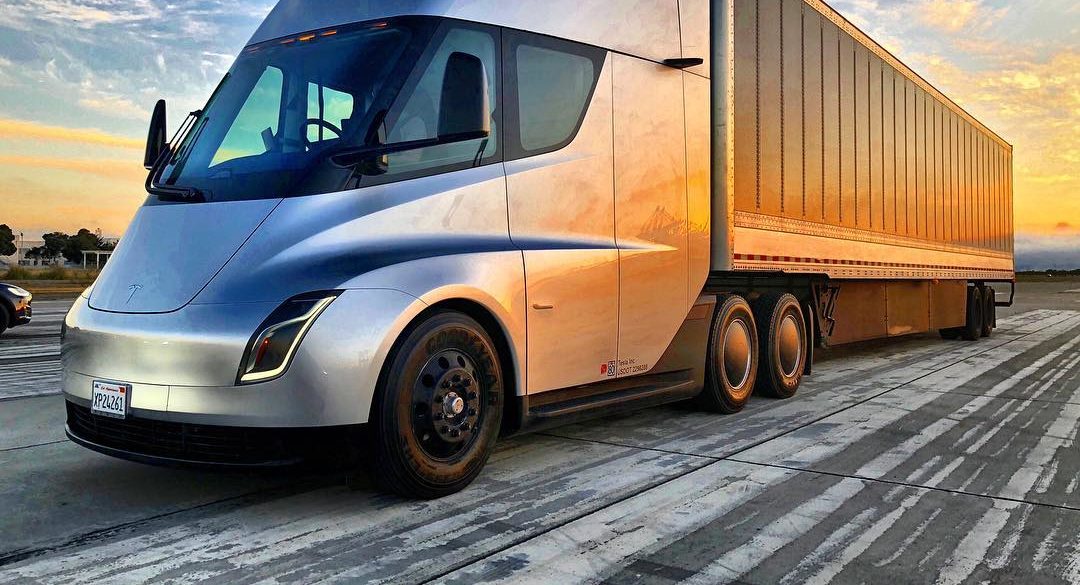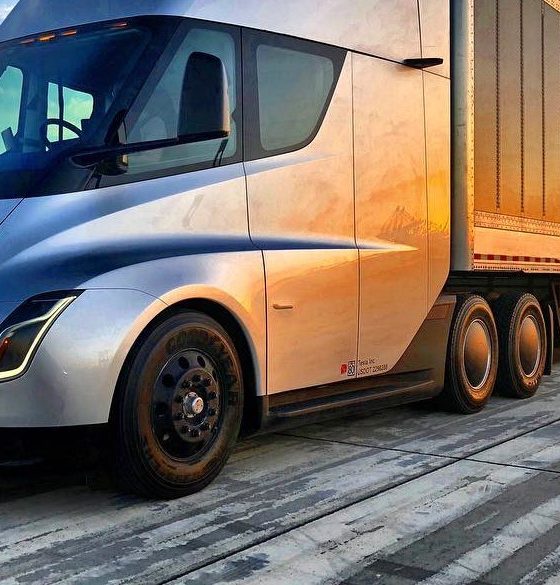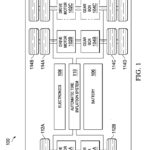

News
Tesla Semi tire inflation patent paves way for pickup truck, Model Y & X’s off-road abilities
During Tesla’s third-quarter earnings call, Elon Musk noted that the company continues to make headway on its future vehicles. Musk noted that he had already approved the production of the Model Y prototype, while pointing out that the company is making progress on the next-generation Roadster and the Tesla Semi. Musk reiterated his enthusiasm about the Tesla pickup truck as well, which he admits is a vehicle he is most excited about.
Some of the improvements to the Tesla Semi appear to have been teased in one of the company’s recently-published patent applications. The patent, which was published on October 18, 2018, and titled “Automatic Tire Inflation System with Thru-Hub Air Feed,” outlined a system enabling Tesla’s vehicles to inflate or deflate their tires as necessary. While several vehicles today already have Automatic Tire Inflation Systems, Tesla’s patent application notes that conventional ATIS have much room for improvement.
“These prior solutions had a number of shortcomings. With some prior art techniques, air was fed through hollow drive axles to a fitting located on the end thereof. The fitting was then coupled to the air inlets of the tires. To couple the air into the hollow drive axles, a rotatingly attached fitting coupled air from an air storage to the inside of the hollow axles. This fitting was subject to leakage of contaminants. These contaminants interfered with the operation of the ATIS and eventually caused the ATIS to fail.”
Diagrams of Tesla’s Automatic Tire Inflation System. [Credit: US Patent Office]
Tesla’s ATIS patent involves a system that features valves, a rotary air seal, and bearings, to avoid contamination. With such a system in place, Tesla notes that the wheels of its vehicles would likely last longer, and tires would require even less maintenance.
“In order to overcome the shortcomings described above among other shortcomings, an Automatic Tire Inflation System (ATIS) for use with a vehicle according to a first described embodiment includes a controller, valves controlled by the controller, the valves having an air supply inlet, and a plurality of air outlets. Further, the ATIS includes, for at least one drive axle having inner bearings and outer bearings, a channel formed in a spindle, first hosing coupling a valve of the valves controlled by the controller to the channel formed in the spindle, a channel formed in a hub, a rotary air seal residing between the inner bearings and the outer bearings and coupling the channel formed in the spindle to the channel formed in the hub, and second hosing coupling the channel formed in the hub to at least one wheel.
“Thus, as compared to the prior ATIS systems, the ATIS of the first embodiment, significantly reduces contamination in the ATIS air stream. Reduction in contamination extends the life of the ATIS, extends spindle life, extends hub life, and extends serviced wheel/tire lives and extends maintenance intervals.”
While the diagrams in the patent application suggest that Tesla’s upcoming ATIS would be used for the Semi, the applications for the automatic tire inflation system for the company’s other, upcoming vehicles are notable. Having the capability to automatically inflate tires depending on the terrain, after all, would allow Tesla to start giving its vehicles some form of off-road capability. Under-inflated tires are key to off-road driving, since they are capable of flexing more, allowing vehicles to “crawl” over rocks and other sharp, irregular terrain. Under-inflated tires also have a wider contact path, allowing vehicles to gain more traction in terrain like deep sand or soft snow.
For now, Tesla’s vehicles are optimized for city and interstate driving, and while there are accounts of the Model X being taken off-road (EV YouTuber Bjorn Nyland’s extreme driving test sessions come to mind), the company’s electric cars are yet to have features that are specifically geared towards off-road driving. With an ATIS system, Tesla’s upcoming vehicles such as the Tesla pickup truck, and even the company’s SUVs like the Model Y and a future iteration of the Model X, could have the ability to explore areas beyond paved roads. Such capabilities would likely be invaluable, considering that legendary vehicles like the Ford F-150 and the Chevy Blazer established their legacies by proving themselves capable in areas where neither asphalt nor concrete is present.
Tesla’s full patent for its Automatic Tire Inflation system could be accessed here.

News
Tesla FSD fleet is nearing 7 billion total miles, including 2.5 billion city miles
As can be seen on Tesla’s official FSD webpage, vehicles equipped with the system have now navigated over 6.99 billion miles.

Tesla’s Full Self-Driving (Supervised) fleet is closing in on almost 7 billion total miles driven, as per data posted by the company on its official FSD webpage.
These figures hint at the massive scale of data fueling Tesla’s rapid FSD improvements, which have been quite notable as of late.
FSD mileage milestones
As can be seen on Tesla’s official FSD webpage, vehicles equipped with the system have now navigated over 6.99 billion miles. Tesla owner and avid FSD tester Whole Mars Catalog also shared a screenshot indicating that from the nearly 7 billion miles traveled by the FSD fleet, more than 2.5 billion miles were driven inside cities.
City miles are particularly valuable for complex urban scenarios like unprotected turns, pedestrian interactions, and traffic lights. This is also the difference-maker for FSD, as only complex solutions, such as Waymo’s self-driving taxis, operate similarly on inner-city streets. And even then, incidents such as the San Francisco blackouts have proven challenging for sensor-rich vehicles like Waymos.
Tesla’s data edge
Tesla has a number of advantages in the autonomous vehicle sector, one of which is the size of its fleet and the number of vehicles training FSD on real-world roads. Tesla’s nearly 7 billion FSD miles then allow the company to roll out updates that make its vehicles behave like they are being driven by experienced drivers, even if they are operating on their own.
So notable are Tesla’s improvements to FSD that NVIDIA Director of Robotics Jim Fan, after experiencing FSD v14, noted that the system is the first AI that passes what he described as a “Physical Turing Test.”
“Despite knowing exactly how robot learning works, I still find it magical watching the steering wheel turn by itself. First it feels surreal, next it becomes routine. Then, like the smartphone, taking it away actively hurts. This is how humanity gets rewired and glued to god-like technologies,” Fan wrote in a post on X.
News
Tesla starts showing how FSD will change lives in Europe
Local officials tested the system on narrow country roads and were impressed by FSD’s smooth, human-like driving, with some calling the service a game-changer for everyday life in areas that are far from urban centers.

Tesla has launched Europe’s first public shuttle service using Full Self-Driving (Supervised) in the rural Eifelkreis Bitburg-Prüm region of Germany, demonstrating how the technology can restore independence and mobility for people who struggle with limited transport options.
Local officials tested the system on narrow country roads and were impressed by FSD’s smooth, human-like driving, with some calling the service a game-changer for everyday life in areas that are far from urban centers.
Officials see real impact on rural residents
Arzfeld Mayor Johannes Kuhl and District Administrator Andreas Kruppert personally tested the Tesla shuttle service. This allowed them to see just how well FSD navigated winding lanes and rural roads confidently. Kruppert said, “Autonomous driving sounds like science fiction to many, but we simply see here that it works totally well in rural regions too.” Kuhl, for his part, also noted that FSD “feels like a very experienced driver.”
The pilot complements the area’s “Citizen Bus” program, which provides on-demand rides for elderly residents who can no longer drive themselves. Tesla Europe shared a video of a demonstration of the service, highlighting how FSD gives people their freedom back, even in places where public transport is not as prevalent.
What the Ministry for Economic Affairs and Transport says
Rhineland-Palatinate’s Minister Daniela Schmitt supported the project, praising the collaboration that made this “first of its kind in Europe” possible. As per the ministry, the rural rollout for the service shows FSD’s potential beyond major cities, and it delivers tangible benefits like grocery runs, doctor visits, and social connections for isolated residents.
“Reliable and flexible mobility is especially vital in rural areas. With the launch of a shuttle service using self-driving vehicles (FSD supervised) by Tesla in the Eifelkreis Bitburg-Prüm, an innovative pilot project is now getting underway that complements local community bus services. It is the first project of its kind in Europe.
“The result is a real gain for rural mobility: greater accessibility, more flexibility and tangible benefits for everyday life. A strong signal for innovation, cooperation and future-oriented mobility beyond urban centers,” the ministry wrote in a LinkedIn post.
News
Tesla China quietly posts Robotaxi-related job listing
Tesla China is currently seeking a Low Voltage Electrical Engineer to work on circuit board design for the company’s autonomous vehicles.

Tesla has posted a new job listing in Shanghai explicitly tied to its Robotaxi program, fueling speculation that the company is preparing to launch its dedicated autonomous ride-hailing service in China.
As noted in the listing, Tesla China is currently seeking a Low Voltage Electrical Engineer to work on circuit board design for the company’s autonomous vehicles.
Robotaxi-specific role
The listing, which was shared on social media platform X by industry watcher @tslaming, suggested that Tesla China is looking to fill the role urgently. The job listing itself specifically mentions that the person hired for the role will be working on the Low Voltage Hardware team, which would design the circuit boards that would serve as the nervous system of the Robotaxi.
Key tasks for the role, as indicated in the job listing, include collaboration with PCB layout, firmware, mechanical, program management, and validation teams, among other responsibilities. The role is based in Shanghai.
China Robotaxi launch
China represents a massive potential market for robotaxis, with its dense urban centers and supportive policies in select cities. Tesla has limited permission to roll out FSD in the country, though despite this, its vehicles have been hailed as among the best in the market when it comes to autonomous features. So far, at least, it appears that China supports Tesla’s FSD and Robotaxi rollout.
This was hinted at in November, when Tesla brought the Cybercab to the 8th China International Import Expo (CIIE) in Shanghai, marking the first time that the autonomous two-seater was brought to the Asia-Pacific region. The vehicle, despite not having a release date in China, received a significant amount of interest among the event’s attendees.










